Blog note: The words are the same as in the back of the book. I will add little bits when I can and it will eventually make full use of photos and hyperlinks. The internet allows a longer definition of each term in the glossary, as well as the addition of photos. Enjoy! If you wish to add to a given definition, please send a message, and I will consider adding your content to the glossary here. In some cases, I provide a hyperlink to a more detailed description of the word or phenomenon it describes.
Glossary of Terms
Author’s note: In low income countries the health care team includes highly educated professionals from many countries. A pidgin language often develops, drawing on the diverse backgrounds. Consequently the daily speech provides a unique flavor to any such setting. A goal of this book is to convey the feeling of daily interaction. The author needed to convey the flavor and balance it with accessibility and readability.
The point at which an English word is substituted is arbitrary; for example everyone in Nepal knows what a Tundikhel is but the author opted to substitute “parade ground” for this even though few parades are likely to be held there. The author begs the reader’s indulgence as to where the comfort zone may lie.
Place names are not included here.
Biblical references are best found in the Bible of the reader’s choice.
Likewise, detailed descriptions of medical procedures which illustrate subtle differences between standards of practice in Nepal vs. the USA or UK, needed to be considered. Every effort has been made to convey the medical procedures in terms used by an educated reader; the author tried to simplify these descriptions but retain the interest of a sophisticated medical audience.
The Civil War – readers wishing to learn more of the Nepal Civil War are invited to find the book’s blog page, www.sacramentofthegoddess.wordpress.com
DISCLAIMER: Descriptions of medical diagnoses or procedures are depicted for narrative purposes only and should not be construed as medical advice. Do not attempt these at home. The reader is advised to consult a licensed physician for treatment of any illness depicted in this book. As soon as possible.
Bahadur – literally “brave” – used as a sort of nickname by members of the chhetri (warrior) caste. Abbreviated “bdr.”
Bahini – “younger sister.”
Bandh – a strike in which motorized traffic is halted and stores are closed. Enforced by gangs of men with lathis who threaten to thrash any violators. A bandh can be local, regional or national.

Bandh. the roadblocks are an essential component of a successful bandh. this photo was taken in 2007. since then, there is an informal eco-bandh agreement to not burn tires.
Bag chaal – “tigers and goats” a board game in the sense of chess or checkers.

Bag-Chaal. this is a nice one, made of brass. a board game. every child learns to play this in Nepal. is it better to be a tiger? or a goat?
Bhai – younger brother.
Bhalu – literally, a bear; slang term for a prostitute. Offensive term.
Bhagavad Gita– a holy book used in Hindu religion.
Bhairava – a manifestation of Shiva. With sharp teeth, he guards every temple door. Bhairava exemplifies fear and the passage of time. Knowledge cannot be gained unless fear is overcome.
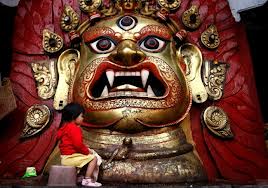
Bhairav. note the fierce expression and sharp teeth. This particular image is famous and locate din Kathmandu, where it is only displayed during the festival of Indra Jatra.
Bijju – literally, the seed stalk of rice at the time of transplanting into the paddy. Figuratively, a slang term for man’s semen. This term is considered to be highly offensive.
Bo tree – ficus religiosa the tree under which Buddha meditated and achieved enlightenment. Distinctive leaves of this tree are symbolic of Buddha.
Bodhicitta– a way of being which promotes better development of positive karma
Bodhisattva – a person of advanced development who postpones personal entry into Nirvana to help his fellow sentient beings achieve better karma.
Boudhanath – largest stupa in the world. Iconic location of Kathmandu. see photos.

Another view of Boudha. I took this photo in 2007 and used it for the cover of my first book. The eyes and the prayer flags add to the ambience. The stupa sits on a structure with 108 corners. from the air it is a giant mandala.
Buddha – an old person, a wise person. “The Buddha” usually refers to Gautama, born at Lumbini Nepal.

Buddha. Note the earlobes. to this day, if a Nepali person has droopy earlobes, they will be nicknamed “Buddha”
Chakra – a site of energy in the body. There are seven chakras. The most prominent in the book is the “third eye chakra”
Cheese and Onion –slang term among medical students used for the spiral-bound Oxford handbook which is an indispensable resource. (used in UK and all Commonwealth countries. Originally the cover was red and yellow like pizza)
Chiya – Nepali tea, boiled with milk and spices. The forerunner of Chai.
Chini – rough crystals of Nepali sugar.
Chowkidar – a uniformed guard. see photo.
Chautara – a rest stop. Usually a stone wall in a raised ring filled with earth into which two trees are planted, a Bo and a Pipal. Found throughout Nepal. The one in Beni has a Sal tree. Specific trees have specific religious connotations. ( see photo)

Chautara at Beni Hospital. In the book, the spot where Ranjit smokes his pipe and holds court. similar structures exist throughout Nepal as a courtesy to foot-travelers.
Chhetri – ethnic group of Nepal, Historically, the warrior caste.
Cimellia – Buddhist symbol that illustrates a teaching. The eight cimellias are: double-fish, lotus, white conch, victory banner, Buddha wheel, auspicious knot, treasure vase and precious umbrella.
Dal bhaat – boiled rice served with lentil soup. The staple of Nepali diet.
Dai – older brother, used with any older male. Often used as a post-fix to the given name, as in “Ranjit dai”
Dakini – a female spirit, sometimes malevolent, that occupies a person’s body. Also, a thought or concept that becomes an obsession.

Dakini. famous sculpture from Changu Narayan which depicts Bhairav removing the heart of a malevolent dakini. proof that the median sternotomy was invented in Nepal.
Dakka cloth – brightly colored hand-woven cloth of Nepal. The best Dakka comes from Palpa district.
Daruwa Suruwal – Men’s traditional outfit.
DBT – frequently used abbreviation for dal-bhaat-terkari.
Dharma – one of the pillars of Buddhism, a book of principals of practical action. “The eightfold path.”
Dhoti – a cotton plaid skirt worn by men the Terai.
Didi – literally, “older sister” but used with any female older than you. In Nepali hospitals, often used to designate the Charge Nurse.
“Din me raat, rat me dat” roughly, “In daytime you see my dark skin, in nighttime you only see how my teeth shine.”
Doko – a packbasket for carrying cargo. Used throughout Nepal, with a tumpline – a rope slung around the carrier’s forehead.

women carrying a sack of potatoes via tumpline, similar to the way a doko would be carried. She is about to get on a tuk tuk. also known as a “tempo.”
Dorje – “lightning bolt,” a symbolic handheld metal implement used in conjunction with a small bell to aid in meditation. About the size and heft of a roll of pennies.
Gajal – a musical genre which came to Nepal from Arabic lands. Also the name for kohl, a type of eye makeup used to enhance romance.
Ghee – purified butter.
Gurkha – member of elite Nepali military unit in service to UK or India or Singapore, serving as mercenaries since 1814.
Gurung – name of ethnic group found mainly in west-central Nepal. Here is a video of a Gurung wedding reception https://youtu.be/IoX0UfxCRTY
Hajur – honorific term to address a person of higher social stature than the speaker.
Honorific – linguistic term for a system of verb conjugation which incorporates the awareness of relative social status into everyday conversation.
Hungry Ghosts – in Vajrayanic Buddhism, one of the six realms of sentient beings. “This is a metaphor for people futilely attempting to fulfill their illusory physical desires” (Wikipedia)
Istha Devi – a personal deity, assigned to an initiate, for the purpose of focusing meditation on Buddhist principles.
Japaa – meditation using a set of beads to keep track of repetition, usually aided by a mantra.
Janai surya – “starting a bond” an engagement party.
Janayuddha Jindabaad – slogan of Maoists which means “Long live the revolution”
Japaa – a form of puja which focuses on the use of repetitive mantras, aided by rakshya beads.
Jatra – a procession, usually involves parading a statue of the deity on a festival day.
Kali – literally, the color black. Also used as a nickname. Also a name for the Goddess of death, “The Black One.” see photo
Karma – the cumulative positive or negative credit built up during this life or a previous life.
Ke Garne – expression in wide use conveying” what to do!”
Kora – “walking meditation” to promote mindfulness. Used by all Buddhists. Here is YouTube link to Kora at Boudhanath.
Kuire – white person (never used in presence of actual white person). offensive
Kukri – the legendary forward-curving knife of Nepal, carried by Gurkhas but also in common use.
Kurtha Suruwal – two piece garment. Trousers plus a top which includes front and back panels or aprons that add extra modesty to the hips and buttocks.
Lama – A Tibetan monk who provides spiritual advice to the lay public.
Lassi – a drink made of yogurt and honey with spices, served as refreshment.

lathis in use. during a bandh. the unfortunate motorcycle driver was attempting to cross a roadblock.
Lathi – a stick of four foot length used to administer a beating.
Lightning bolt – also known as a dorje. Symbol of man’s virility and knowledge. see “dorje”
Lotus flower – Buddhist symbol of femininity.
Loadshedding – rolling power blackouts used to share electricity.
Machhendranath – name of an annual festival in Patan, during which a large-wheeled cart is hauled through the city, to display the relic of the God who protects the people there.
Maoists – the communist-inspired revolutionaries. This term refers to the underground civilian guerilla combatants.
MBBS – “Bachelor of Medicine and Surgery” abbreviation for the academic degree associated with the course of medical study in Nepal and Commonwealth countries.
Mehendi – henna dye, applied to the skin in fanciful designs, a temporary tattoo.
Mindfulness – a key precept in Buddhism. Being aware of your own bodily response to simple activities. And so much more.
Mojo –. The essence of manhood which propels the life force forward. Not a Nepali term.
Momo – a meat dumpling that is steamed. Originally a Tibetan dish, now found throughout Nepal.
Mudra – one of the set of hand gestures used in classical Hinduism.
Mumu – a Hawaiian one-piece loosefitting woman’s garment that goes down to the ankles.
Namaste– a greeting used to acknowledge the divinity that exists in all fellow human beings.
Newari – a major ethnic group in Nepal, based mainly in Kathmandu but with outposts throughout the country.
NGO – Non-Governmental Organization.
Puja – ceremony of prayer. Usually involves eight offerings: drinking water, bathing water, flowers, incense, light, perfume, food and music. Different deities are associated with specific offerings and rituals.

typical puja setup. the framed posters are widely available and inexpensive, to promote religion among the people whether they have money or not.
Pakka – Hindi for “proper.”
Pashmina – woven cloth made from the belly wool of a Nepali goat. Better than cashmere!
Pedicab – three wheeled bicycle. Driver pedals from a bicycle seat and passengers sit in a seat over the main axle
PLA – “People’s Liberation Army” – the military wing of the Maoists. Please refer to website for more detailed backstory of civil war.

Maoist soldiers – the People’s Liberation Army. the soldier in the front holds an AK-47; behind her another soldier holds a Lee-Enfield rifle.
Police Force – (often “the armed police”). A military force designed to pacify the Maoist areas, given better weapons than the local police.
Raksi – homemade distilled alcohol based on rice. Very potent.
Rinpoche – in Tibetan Buddhism, a person with documented rebirth from a previous life.
Rodhi – an ad hoc kinship group of youth, particularly among Gurungs, that serves as a social unit.
RNA – “Royal Nepal Army” – the military employed by the King. Heavy weapons including attack helicopters.
Roti – bread, similar to a tortilla.
Rum Doodle – highest mountain of the Himalayan range – 40,000 and 1/2 feet. Inspiration behind the eating and drinking establishment of the same name in Thamel.
Rundi – prostitute. (derogatory term not used in polite company)
Sanga – one of the three pillars of Buddhism. The cohort of people with whom you share this life.
Sadhu – an ascetic Hindu holy man who has renounced material goods
Santoshi Mata – the Goddess of satisfaction. daughter of Ganesh. relatively recent addition to Hindu pantheon.

santoshi mata poster. the objects and figures in the foreground remind the worshipper of the ritual items needed for proper puja.
Sar – “sir” usually a post fix for a respected male.
Shakti – the female goddess of pure sensuality.
Shangri-La – a legendary paradise in a hidden valley of the Himalaya described by James Hilton in the book “Lost Horizon” (1933). link to YouTube of 1937 movie.
Shiva– prime Hindu deity. The essence of maleness.
Sindoor – a streak of red coloring in the center part of a woman’s hair that indicates she is married.
Sel roti – a type of bread made by dropping liquid dough into boiling oil, usually in a ring shape
Sky Burial – in which the body of a deceased person is left for vultures to eat. click here for YouTube link. viewer discretion advised.
Tandoori – a clay oven used to bake bread and other foods.
Tantra – “the third way” of knowledge, embracing direct experience of pleasures and pain. Best embarked upon under the guidance of a guru.
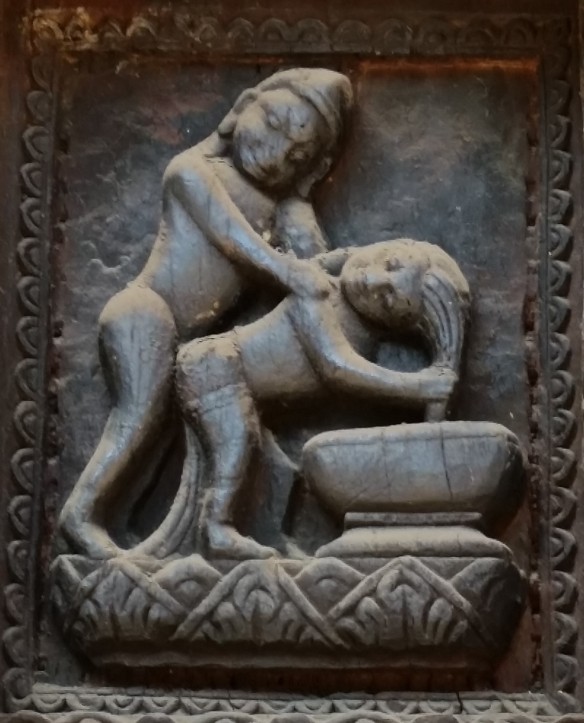
decorative cae strving on the strut of a temple in Bhaktapur, Nepal. Maybe he is assisting with her shampoo.
Tap – water source, usually one which has been improved with a spout or spigot.
Thapa – caste name. Often for a person of the Magar group, not always
Third Eye – the sixth chakra. Generally a symbol for tantric wisdom.
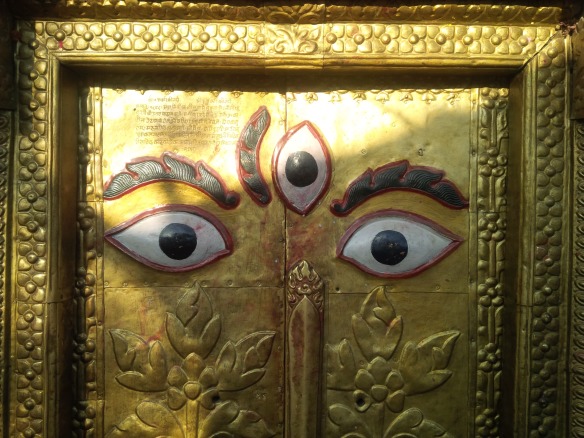
From a temple door in Kathmandu, dedicated hridto Kali. We all have a third eye. Some of us can use it. Most lack the skill to do so.
Third World Country – now considered a demeaning term. “Low Income Country” is more appropriate.
Thrashing – frontier justice administered by a group of men with lathis, often to the point of death. ( see “lathis” above)
and another photo of “thrashing”
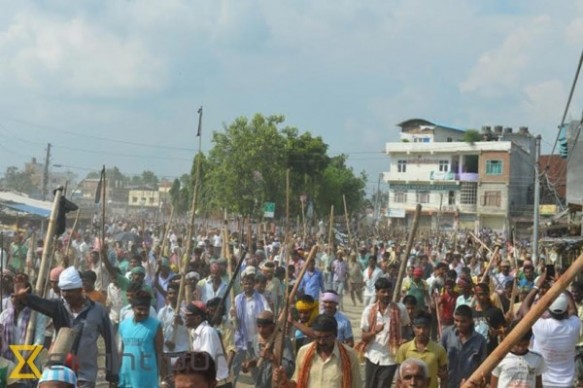
from Republica, Sept 15th 2015 showing a “Stick Rally” in Sirlahi. If a large group of men show up with these, it is not a good sign. This rally happened to be peaceful.
Thugpa – a kind of Tibetan noodle soup
Tika – a mark on the forehead over the “third eye”
Topi – the small cap, usually of daka cloth, worn by Nepali men. The best are made from cloth handwoven in Palpa district, Nepal.
Tout – a self-appointed hustler who serves as a middleman in getting through some known point of bureaucratic bottleneck such as customs or the government.
Tuk tuk – small motor vehicle used to transport over short distances.
Tundikhel – parade ground; usually a large flat place in a city.
Vajrayogini – a very specific manifestation of the female Goddess, popular in Vajrayanic Buddhist worship.
Videshi – foreign person
Yak – an animal found in the Himalaya and Mongolia, domesticated for transport










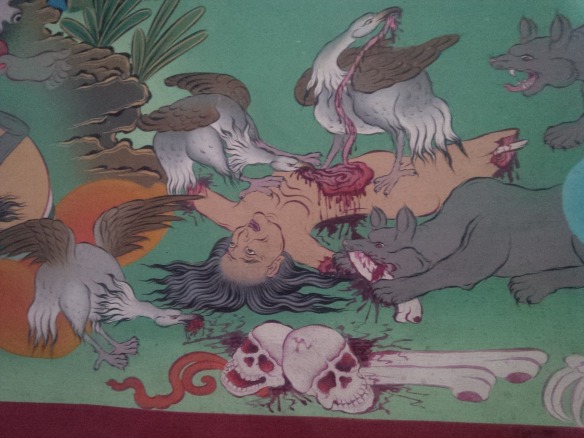
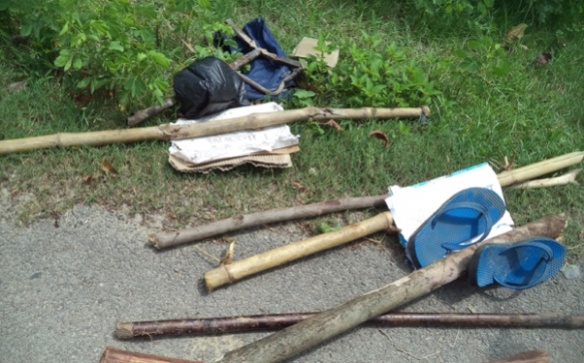


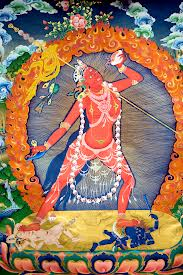
Pingback: Julie and Lucas’ climbing wall “date” in Rockville, Md at Earth Treks | Joe's Junk Drawer
Onion and cheese??? i didnot get it…
All chhetris are not of dark complextion.
Thapa is not just a magar…some Thapas are chhetri too…infact many of them are chhetri…
Kukri??? Khukuri is proper spelling…
cheers…
Thanks. I’ll fix
Pingback: Welcome Nurse Eye Roll fans! | CCNEPal 2015
Is kuire offensive? What’s the non-offensive term for a white person? Gora?(but that’s Hindi)
If they wish to note that you are non-Nepali and be polite, the word choice would be “videshi.”
The language is constructed with “honorifics” through and through, an exquisite reminder of relative social status between the speaker and the listener.